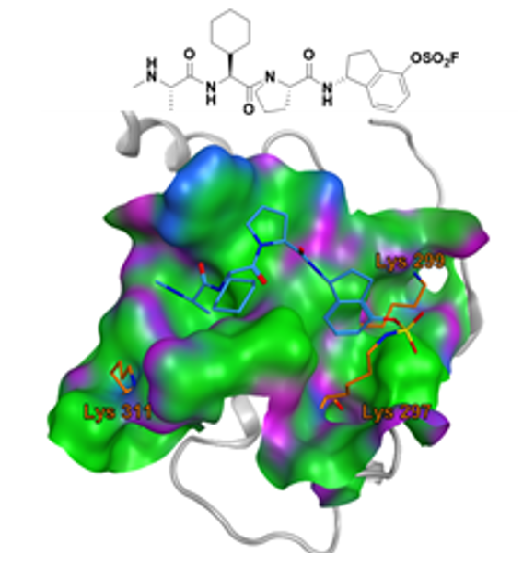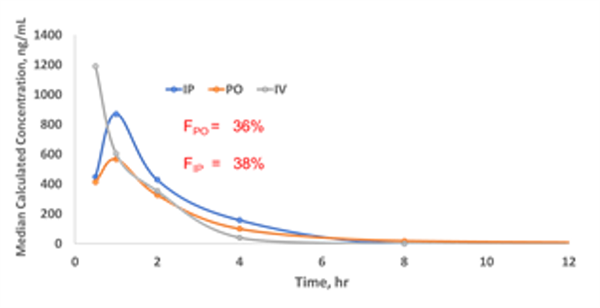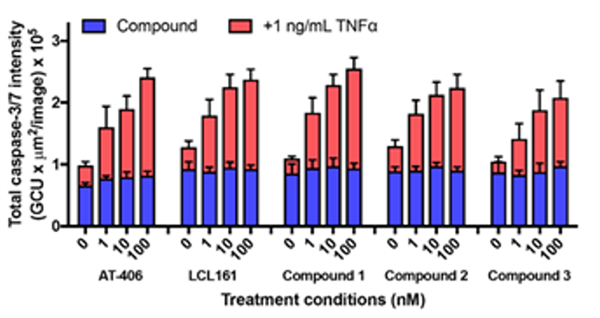Lys-Covalent Pan-Inhibitors of Apoptosis Proteins (IAP) as Innovative Cancer Therapeutics
Background
Currently second mitochondrial-derived activator of caspases (SMAC) mimetics such as LCL161 from Novartis and Debio1143 from Debiopharm are in or have completed Phase II cancer clinical trials. In fact, data from the Debiopharm Phase II trial was so compelling that the FDA granted a Breakthrough Therapy Designation for Debio1143. These SMAC mimetics are pan-inhibitors of apoptosis proteins (IAP) specifically they inhibit cIAP1, cIAP2 and XIAP.
Certain cancers are resistant to chemotherapy; IAP inhibitors are now tested in the clinic in combination with existing therapies like carboplatin to treat these chemoresistant cancers. Given the validation of the IAP target in cancer, new IAP inhibitors with improved safety and efficacy profiles are desirable.
Brief Description
Prof. Maurizio Pellecchia and his colleagues at the University of California, Riverside (UCR) have developed novel Lys-covalent IAP inhibitors (Fig. 1) with low nanomolar activity and favorable PK (Fig. 2). When compared to Debio1143 (aka AT-406) and LCL 161, the UCR compounds have improved activity being irreversible.
Recently, new irreversible therapeutics in oncology have been developed as potential therapies for a variety of cancer. These irreversible agents present improved pharmacodynamics/ pharmacokinetics (PD/PK) properties over reversible agents, but their design is limited to targets that present a Cys residue within their binding site. UCR deployed a technology consisting of introducing a stable aryl-fluorosulfate electrophile that selectively interacts with Lys residues. UCR Compound 1 (Fig 1) is a potent, pan-IAP, Lys-covalent agent with favorable cell permeability and PK properties and that is likely superior to Debio1143 and LCL161 (Fig. 3).

Fig. 1 Chemical composition and covalent docking of compound 1 in the binding pocket of the BIR3 domain of XIAP.

Fig. 2 PK studies in mice with compound 1.

Fig. 3 TNF sensitization of resistant melanoma cells by AT-406 (aka Debio 1143), LCL161 and the UCR compounds.
Application
These IAP inhibitors may be used to target a variety of cancers as a monotherapy or a combination therapy.
Patent Status
| Country | Type | Number | Dated | Case |
| United States Of America | Issued Patent | 11,590,197 | 02/28/2023 | 2017-858 |
Related Materials
- Baggio C., et al. Aryl-fluorosulfate-based Lysine Covalent Pan-Inhibitors of Apoptosis Protein (IAP) Antagonists with Cellular Efficacy. J Med Chem., 62 (20), 9188-9200 (2019). - 09/24/2019
- Baggio C., et al. Design of Potent pan-IAP and Lys-Covalent XIAP Selective Inhibitors Using a Thermodynamics Driven Approach. J Med Chem., 61, 14, 6350–6363 (2018). - 06/25/2018
Contact
- Grace Yee
- grace.yee@ucr.edu
- tel: View Phone Number.
Other Information
Keywords
pancreatic, head and neck, ovarian, melanoma, non-small cell lung cancer, NSCLC, Lys-covalent drug, IAP, SMAC
